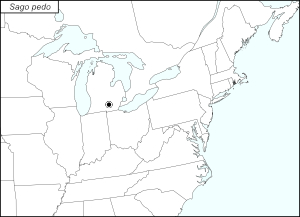|
Alien origin and spread of this SINA species.
|
|
Identification:
|
Forelegs adapted for holding prey; rows of strong spines along inside and outside lower edges of femur and tibia. No males; females large and wingless. Known only from Jackson County, Michigan. Length 60–65 mm.
|
|
Habitat:
|
Old fields.
|
|
Season:
|
August and September. Eggs apparently require more than one winter to hatch.
|
|
Similar species:
|
None.
|
|
Remarks:
|
A reasonable hypothesis as to how the matriarchal katydid was brought to Jackson County, Michigan is that one or more of its eggs were in soil adhering to farm equipment returning from plowing contests in Italy. The first Michigan specimen was collected in 1970 and only six have been taken since. Unlike our native katydids and other species of Saga in Europe, the matriarchal katydid is obligatorily parthenogenetic. No males are known from here or from Europe. Even though there is no male calling song, females have prominent tympanal organs on the fore tibiae.
A caged female inserted eggs in soil to a depth of about 25 mm, and captured and avidly ate grasshoppers. Some grasshoppers use acoustical signals in sexual pair formation, which makes one wonder if matriarchal katydids use their tibial hearing organs to detect and home on signalling prey.
|
|
More information:
|
Subfamily Saginae.
|
|
References:
|
Cantrall 1972.
|
|
Nomenclature:
|
OSF (Orthoptera Species File Online).
|







